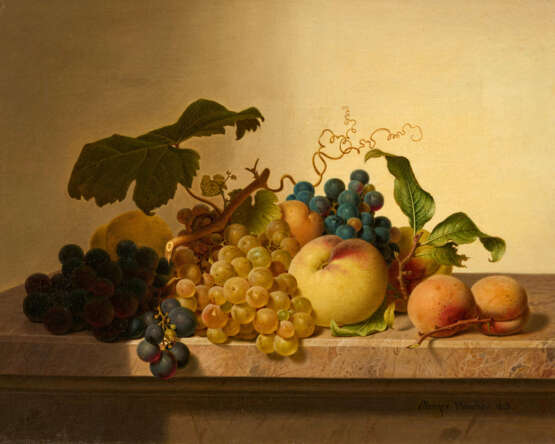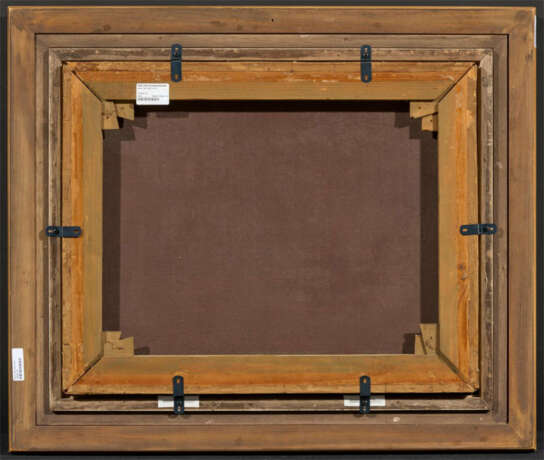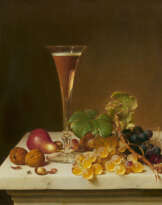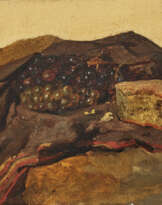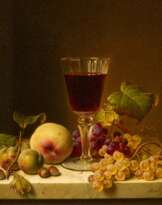ID 1319837
Lot 1268 | Johann Wilhelm Preyer. Still Life with Grapes, Peaches and Apricots
Valeur estimée
€ 35 000 – 45 000
1803 Rheydt - 1889 Düsseldorf
Title:
Still Life with Grapes, Peaches and Apricots.
Date:
1848.
Technique:
Oil on canvas.
Measurement:
41.5 x 51cm.
Notation:
Signed and dated lower right: "J.W.Preyer München 1848".
Frame:
Framed.
Provenance:
Private ownership, Germany;
Collection Dirk and Ursula Budde, Kerken.
Johann Wilhelm Preyer and his daughter Emilie are certainly among the most important German still life painters of the 19th century.
Johann Wilhelm Preyer received comprehensive training at the Academy of Art in Düsseldorf from 1822, initially under Peter Cornelius and then as a master student of Wilhelm Schadow. From the late 1820s onwards, he concentrated on still lifes.
The young artist travelled to Holland and Italy for around 10 years, also living in Munich for a few years during this time before settling back in Düsseldorf in 1844.
Still lifes were held in rather low esteem in academy circles. However, Johann Wilhelm Preyer was soon able to overcome this. His works quickly met with great success among the public, critics and collectors. His technical virtuosity in painting, with which he was able to reproduce the plasticity of objects and the texture of surfaces, fascinated viewers just as much as the special mood of light (catalogue 1268) and the strict composition of his works. The paintings in which Johann Wilhelm Preyer arranged grapes next to their alcoholic products in fine glasses are also very popular (catalogue 1269 and 1270). The demand for Preyer's paintings eventually became so great that he painted to order for domestic and foreign customers and lived in secure prosperity.
Johann Wilhelm Preyer himself did not attend the academy as a teacher, instead giving private painting lessons, mainly to female pupils. When the artistic talent of his daughter Emilie, born in 1849, became apparent, she was denied official training as a woman. Fortunately, she had a 'painter father' who encouraged her great talent. He trained her and was also able to recruit fellow artists and professors Heinrich Mücke and Hans Fredrik Gude as private teachers for his daughter.
Emilie Preyer is certainly her father's best pupil and a worthy successor. At the highest level of painting technique, she largely followed her father in her choice of motifs. As her particular speciality, she uses the batiste tablecloth as a base for the arranged fruit. Her daughter's paintings differ from her father's in their treatment of light in particular. In Johann Wilhelm Preyer's works, there is always a defined incidence of light, but his arranged objects seem to be 'enveloped' in light. Emilie usually illuminates her motifs more harshly, almost objectively. In doing so, she explored a way of seeing that would be influential in the 1920s.
Emilie Preyer certainly benefited from her father's fame and his contacts with dealers and collectors, but she soon succeeded in being recognised as a successful artist in her own right. In the United States in particular, she had a solid circle of collectors and was able to live independently as a painter by selling her brilliant still lifes.
| Artiste: | Johann Wilhelm Preyer (1803 - 1889) |
|---|---|
| Technique appliquée: | Huile |
| Catégorie maison de vente aux enchères: | Peintures de maîtres récents |
| Artiste: | Johann Wilhelm Preyer (1803 - 1889) |
|---|---|
| Technique appliquée: | Huile |
| Catégorie maison de vente aux enchères: | Peintures de maîtres récents |
| Adresse de l'enchère |
VAN HAM Kunstauktionen GmbH Hitzelerstr. 2 50968 Köln Allemagne | ||||||||||||||
|---|---|---|---|---|---|---|---|---|---|---|---|---|---|---|---|
| Aperçu | |||||||||||||||
| Téléphone | +49 221 92586215 | ||||||||||||||
| Fax | +49 221 92 58 62 4 | ||||||||||||||
| Commission | 32% | ||||||||||||||
| Conditions d'utilisation | Conditions d'utilisation | ||||||||||||||
| Heures d'ouverture | Heures d'ouverture
|
